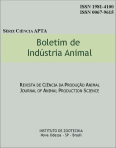Produtive performance of Nile tilapia in cages in a rural dam, Vale do Ribeira, SP, Brazil
DOI:
https://doi.org/10.17523/bia.v71n3p256Keywords:
intensive system, stocking density, good rearing practicesAbstract
This study aimed to evaluate the adequate fish stocking density for intensive rearing in fresh water cage system at Vale do Ribeira region. Present study was conducted in Pariquera-Açu municipalities, in the Pisciculture sector of Polo Regional do Vale do Ribeira of APTA (SAA, SP) from november of 2012 to april of 2013. Eighteen cages of 4 m3, arranged in three lines, with 50 m, in a rural reservoir of 2.7 hectares were installed. A production cycle was done using 10,800 Nile tilapia juveniles, Oreochromis niloticus, with initial average weight of 25 ± 3.0 g divided in three stocking densities of 100, 150 and 200 fish/m3, with six replication of each stocking density. Fish performance in each cage was evaluated, in each 30th days, by the achievement of daily weight gain, final weight gain, apparent food conversion, survival and final average biomass (4 m3). For water quality determination of the rural reservoir, it was marked five points of sampling: water supply, rearing area divided in three points at 10 cm depth and effluent. Related to final length, final weight, final weight gain and survival there was significant difference (P<0.05) between the smallest and the highest stocking density. However, in relation to feed conversion the highest density (200 fish/m3) had the better result. Water quality parameters were adequate to tropical fish rearing patterns and to CONAMA 357/05 resolution. Performance data of this research show the viability of cage system with density 150 fish/m3 in Vale do Ribeira region.This study aimed to evaluate the adequate fish stocking density for intensive rearing in fresh water cage system at Vale do Ribeira region. Present study was conducted in Pariquera-Açu municipalities, in the Pisciculture sector of Polo Regional do Vale do Ribeira of APTA (SAA, SP) from november of 2012 to april of 2013. Eighteen cages of 4 m3, arranged in three lines, with 50 m, in a rural reservoir of 2.7 hectares were installed. A production cycle was done using 10,800 Nile tilapia juveniles, Oreochromis niloticus, with initial average weight of 25 ± 3.0 g divided in three stocking densities of 100, 150 and 200 fish/m3, with six replication of each stocking density. Fish performance in each cage was evaluated, in each 30th days, by the achievement of daily weight gain, final weight gain, apparent food conversion, survival and final average biomass (4 m3). For water quality determination of the rural reservoir, it was marked five points of sampling: water supply, rearing area divided in three points at 10 cm depth and effluent. Related to final length, final weight, final weight gain and survival there was significant difference (P<0.05) between the smallest and the highest stocking density. However, in relation to feed conversion the highest density (200 fish/m3) had the better result. Water quality parameters were adequate to tropical fish rearing patterns and to CONAMA 357/05 resolution. Performance data of this research show the viability of cage system with density 150 fish/m3 in Vale do Ribeira region.Downloads
Downloads
Published
Issue
Section
License
Os autores não serão remunerados pela publicação de trabalhos, pois devem abrir mão de seus direitos autorais em favor deste periódico. Por outro lado, os autores ficam autorizados a publicar seus artigos, simultaneamente, em repositórios da instituição de sua origem, desde que citada a fonte da publicação original seja Boletim de Indústria Animal. A revista se reserva o direito de efetuar, nos originais, alterações de ordem normativa, ortográfica e gramatical, com vistas a manter o padrão culto da língua e a credibilidade do veículo. Respeitará, no entanto, o estilo de escrever dos autores. Alterações, correções ou sugestões de ordem conceitual serão encaminhadas aos autores, quando necessário. Nesses casos, os artigos, depois de adequados, deverão ser submetidos a nova apreciação. As opiniões emitidas pelos autores dos artigos são de sua exclusiva responsabilidade. Todo o conteúdo deste periódico, exceto onde está identificado, está licenciado sob a Licença Creative Commons Attribution (CC-BY-NC). A condição BY implica que os licenciados podem copiar, distribuir, exibir e executar a obra e fazer trabalhos derivados com base em que só se dão o autor ou licenciante os créditos na forma especificada por estes. A cláusula NC significa que os licenciados podem copiar, distribuir, exibir e executar a obra e fazer trabalhos derivados com base apenas para fins não comerciais.













